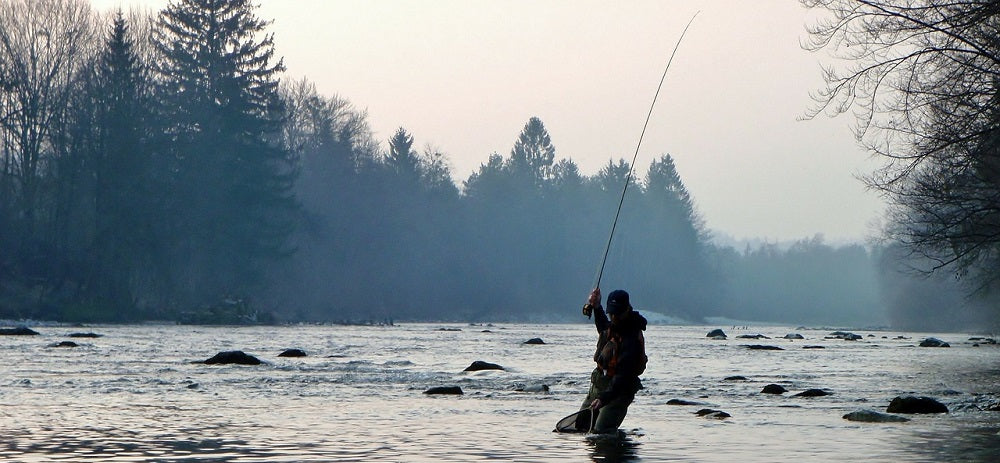
The sky cracks open and water comes down in buckets. You get soaked. The river turns into chocolate milk. Do you call it a day or keep casting? Sometimes rain can trigger a flurry of trout activity while other times it shuts down the bite for the rest of the day. To help you make a plan of action when the weather interrupts your efforts, here are some fly fishing in the rain tips and techniques to put to use before, during, and after a storm.
Grab your fishing rain gear and let's go!
Before The Storm – Take Advantage Of Low-Light Conditions

As a general rule of thumb, trout and the aquatic insects they eat are more active in low light conditions. Maybe they feel less vulnerable to predators from above, or maybe it's the change in barometric pressure that occurs when a front moves in that sets them off. Whatever the reason, if skies are cloudy you should be on the water and ready to capitalize on pre-storm conditions.
Cloudy mornings before a storm will often produce excellent hatches. So come prepared with a selection of dry flies. Bring whichever are known to produce on your local stream with a range of sizes to match the hatch. Don't forget to throw in a few emerger imitations, which imitate hatching bugs as they ascend to the surface. Also, if you aren't dry fly savvy, fishing nymphs can be especially productive during a hatch.
While you won't need to alter your normal fly fishing tactics before the rain picks up, you may want to reach for dark-colored fly patterns to match the low-light conditions. Darker colored flies offer more contrast against the gray sky which can help trout see your offerings better.
During The Downpour – Target Slow Water & Be Willing To Experiment

When fly fishing in the rain, be prepared to switch up your entire fly rig and presentation strategy.
Warning: If there is lightning anywhere near where you're fishing, do the smart thing and get out of the river! Waving a 9-foot graphite rod is one of the worst things you can do in an electrical storm. The fish can wait!
One of the best things that happen while trout fishing in the rain is that insects in the streamside brush and banks get washed into the water. Grasshoppers, beetles, ants, worms—all the juicy meals trout love.
As long as the rain isn't hitting the water too hard, you should be able to fish big foam dry flies—like hoppers or beetles—to match the influx of food that gets bumped into the river by the rain.
Now, keep in mind that when lots of water is entering the stream, the water level is likely to rise and the current speed will increase. This means that your favorite riffles and current seams might be blown out and therefore not fishable.
So Where Should You Present Your Flies Instead?
When fly fishing in the rain, look for eddies and pockets of slow-moving water along the banks. In these areas of slack water, trout have an easier time coping with the change in stream conditions affected by the rain, which often includes an increase in water turbidity as well as temperature. Fish your hopper nice and slow through these pools, targeting any foam lines or prominent structure in the vicinity. And give your fly an occasional twitch or jerk to trigger a strike.
Don't limit yourself to only fishing terrestrials, though. Times of heavy rainfall are perfect for experimenting with big streamers, especially patterns with primarily dark colors—black, olive, or brown. If you’re wondering whether fish bite in the rain, there’s only one way to find out for sure! Get out there. Experiment with nymphs, too. There are no rules when trout fishing in the rain. Experiment, seek out that slower water, and when in doubt, reach for darker-colored flies.
Fly Fishing After Heavy Rain – Bring On The Hatches!

If you've managed to stay strong through the deluge, there's a good chance you'll be rewarded with the fly angler's dream—an epic hatch. In many trout streams throughout the U.S., blue-winged olives and midges will make a big showing after a rainstorm. So, when that rain clears up, tie on your favorite imitation, cast out and mend line to achieve a sweet, sweet, drag-free drift.
Depending on where you are in the country, you might be lucky enough to experience a stonefly or salmonfly hatch after a rainstorm. In that case, you might try fishing a large stonefly nymph or go for the big-daddy winged adult stonefly.
Rain-Ready All Weather Fishing Gear
A good jacket is indispensable when fly fishing in the rain. However, to cast effectively, you want something that won't weigh you down—like the Huk Packable Rain Jacket. The jacket is wind proof and packs into its own pouch and can be stowed just about anywhere . It's one of the best jackets for fishing in the rain. Check out the full Huk Fishing Rain Gear collection here.Don't Let Rain Keep You Off the River
So, is trout fishing good in the rain? It certainly can be. If you're planning a day on the trout stream but there's rain in the forecast, head out anyway. Use the fly fishing in the rain tips and strategies we've gone over today and hope that the rain and low-light conditions set off a massive hatch that get those trout fired up!








